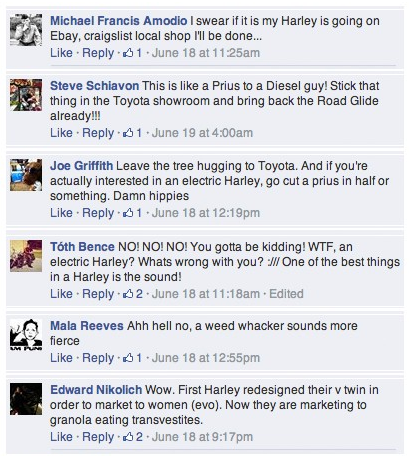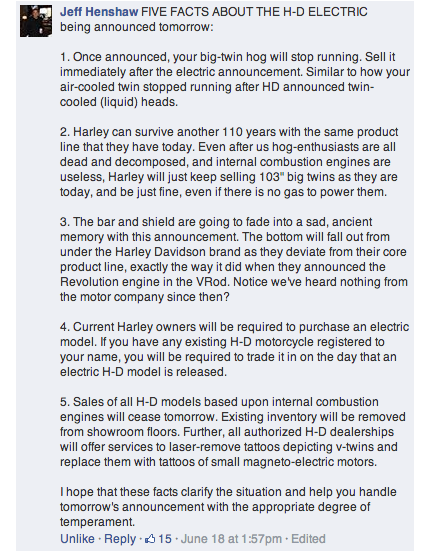Dear Harley Davidson
June 24, 2014Dear Harley-Davidson,
June 19, 2014 was a big day for you. It may have been one of the biggest days in the motor company’s history since rolling the first production motorcycle of out a small shed in Milwaukee, Wisconsin in 1903.
You announced a new generation of motorcycles powered solely by electricity: “Project Livewire.”
In doing so, you took on enormous risk. You risk alienating one of the most loyal customer bases in any industry. You risk confusing one of America’s most recognizable brands — the bar and shield — which has long been associated with strong tradition and heritage. You risk creating a new line of motorcycles that nobody wants with styling and a power train that are radically different than anything you have built before.
These decisions certainly weren’t taken lightly. There were corporate strategists, designers, marketers, engineers, brand managers, risk assessors and others involved in H-D’s decision to go forward with Project Livewire.
You opted for a “soft launch” consisting of an announcement, a worldwide tour offering test rides, and an invitation for customer feedback. This letter provides that feedback in a way that a tweet or Facebook comment can’t. Given the risk you’ve taken on with Project Livewire, you deserve thoughtful feedback from veteran, recent, and potential customers alike.
My feedback takes the form of congratulations and caution and encouragement. I offer it as a Harley-Davidson fan, having owned a new factory-ordered 2005 Road King Custom (still my favorite) and a new 2012 Ultra Limited with significant customization. I love the rumble of my 103 cubic inch v-twin engine as much as anyone, and have enjoyed the big twin bikes. They are — and will continue to be — great motorcycles.
 Harley-Davidson’s Project Livewire
Harley-Davidson’s Project Livewire
Congratulations!
In announcing Project Livewire, you did something amazing: you surprised almost everyone in the motorcycle industry. What you announced is incredibly important… less because of the surprise, and more because of what it represents for H-D’s future.
For many years, it has been clear that you need to attract a younger, broader generation of riders. The vast majority of new big twin purchasers are older riders, baby boomers or close descendants. They’re mostly white. They’re almost all male. They’re professionals with enough disposable income to buy a comparatively expensive luxury item like a top-brand motorcycle. They provide a demand that’s as healthy as the U.S. and world economies. You’ve done reasonably good work at growing nascent markets with campaigns targeted at women buyers, ethnic groups with campaigns like Harlistas (Latino), and Iron Elite (African Americans). But those campaigns are generating incremental demand at best.
You also learned a hard lesson during the global economic recession, as your sales suffered to the point of requiring a significant restructuring of your operations amidst the threat of layoffs. You literally battled your employee unions to the brink of work stoppage to get costs under control in the midst of severely depressed sales.
As the U.S. and world economies begin to improve, so have H-D’s sales. Your traditinal lines of Sportsters, Softails, Dynas and tourers are rolling into the garages of “chap-wearing dentists” once again. But you surely still feel the sting of recession-induced wounds. Under CEO Keith Wandell, you’ve come a long ways in driving efficiency into your operations, and can look forward with an eye toward growth.
 The H-D Street 500, aimed at new global markets.
The H-D Street 500, aimed at new global markets.
For years, I have advocated for Harley-Davidson to reach broader audiences with smaller-displacement, less expensive motorcycles. Not solely for the U.S. market, but to enable growth in India and Asia, where sub-500cc (often sub-200cc) motorcycles provide basic transportation for millions of people. Here in the States, a new generation of riders, largely centered in urban areas, may have demand for the legendary Harley-Davidson brand but not want a large-displacement heavyweight bike, and likely can’t afford one.
You have set yourself up to capitalize on these opportunities with the Street 500 and Street 750 models. They’re modern, liquid-cooled bikes at a more affordable price than most people associate with H-D.
But what I, and few others, expected was the follow-up that Project Livewire delivers. For the first time in decades, it feels like the motor company has quietly, ambitiously been working on something geared entirely for the future. Livewire represents a vision for styling, technology, and real-world in-city riding that nobody expects because most of us anticipate incremental improvements to your decades-old line up. They expect marginally updated technology wrapped in heritage-based styling that proves awkward for most buyers. They expect you to be catching up to what you should have been working on ten or twenty years ago.
Sadly, some of the last things that people expect from Harley-Davidson are true innovation, genuine risk, and pointing out new directions for the motorcycle industry versus rehashing where it has been. Congratulations on proving that preconception wrong!
Thank you for showing that America’s legendary motorcycle company can lead competitors into the future with innovative new concepts. Many of us are proud of you.
Words of Caution
You’re being conservative in your introduction of Project Livewire. Your tour is supposedly geared at collecting feedback from customers. We’ve all heard Henry Ford’s quote about customer feedback as he was innovating in automobile production:
“If I had asked people what they wanted, they would have said faster horses.”
It’s guaranteed that a large percentage of your current customer base is going to react negatively. You’ve marketed Harley-Davidson motorcycles as lifestyle purchases for years. In doing so, you sold the heritage, the family, the brand, and the legend along with great bikes. People who bought into those values and made significant purchase decisions based upon them will want to see those values upheld above all else. The same enviable asset that you have in one of the strongest lifestyle brands on the planet is also one of your greatest liabilities, as that same lifestyle establishes resistance to change.
The worst possible source of feedback will be the offended extremists. This term describes those who subscribe to the lifestyle and brand to the point of exclusivity. They’ll be offended that you would entertain ideas outside of their investments. They’ll suggest that one company cannot be both rich in heritage and innovative. They’ll react with bile, like…

This is a sample from just one Facebook thread; there are thousands more. These people don’t want a new platform. They bought the lifestyle and personal validation that Harley-Davidson sold them. They bought the big twin, put loud pipes on it, wear the H-D logo’d leathers, and buy t-shirts at every dealership in cities that they visit (as do I!). But having bought into the lifestyle isn’t enough for them. They need continued validation in the form of everyone else being forced to appreciate, and subscribe to, what they have. The notion that Harley would build a bike for a different audience is offensive to them, because it suggests that something other than their view might be valid. It’s ridiculous in the extreme.

Some posters, like Michael above, threaten to sell their own Harley if Project Livewire becomes a reality. Many others discuss buying an Indian as an alternative “real” motorcycle. Ironically, Indian is owned by Polaris Industries, who have a significant stake in Brammo, the makers of electric motorcycles. Indeed, sell that Hog you love and buy an Indian to escape electri… oh never mind!
While these are you customers and you need to value and nurture them, don’t let them influence your future direction outside of forecasting big twin production volumes. No rational arguements will influence them, and they will lead you to irrelevance. I do my best to find humor in them; it’s more than they deserve from people who truly care about H-D’s long term health and growth.
While their volume will be loud, and their feedback irrationally scathing, I caution you to recognize that they are not offering you value on H-D’s strategy. They’re begging for validation of the lifestyle choice that they have made. Their insecurity drives them to bash anything unlike what they know. They pay you and you should thank them, but they can’t see beyond their own handlebars so you should not over-value their feedback on your innovation path.

Encouragement
You’ve done a great job with styling while focusing on technology. You leaned toward the sport riding market who are most likely to adopt an early technology.
You’ve also begun building an important message about how Harley-Davidson has relied upon innovation to move forward through the generations. Beginning in the Milwaukee shed, continuing through early days of board track and hill climb races, ramping production up to support global war efforts, and more… you are tying this pivotal look forward to the heritage that has made Harley-Davidson great.
You must move faster.
The industry has seen many attempts to build mainstream electric motorcycles. Zero Motorcycles and Brammo both have well-developed models. Brammo benefits from investment capital from one of your most threatening competitors: Polaris Industries / Indian Motorcycles.
Seeing the trailer full of prototype Livewire electric motorcycles above give me hope that you’re closer to production that you’ll admit. The tour will be a great opportunity to spend time introducing people to the product and getting some helpful feedback.

I encourage you to be realistic about what you need to accomplish in order to better Zero and Brammo, and provide more than just a global brand atop the same offerings that they have had on the market for years. It amounts to three things:
First, deliver better range. It’s the one of the biggest barriers to adoption that the electric motorcycle industry faces. Brammo claims, “Over 100 m.p.h. and over 100 miles per charge.” That’s optimistic and depends strongly on the type of riding you’re doing. Unequivocally beat Brammo’s range. Current and and near-future battery technology are not going to enable you to compete directly with gasoline engines. You’ll be selling to urban riders with a travel patterns than enables multi-hour charging intervals. Your job is to make range less of an issue than your competitors.
Second, use H-D’s unique production scale, both domestic and abroad, to significantly undercut the competition on price. By nature of their capabilities, electric bikes compete with small- to mid-range petrol motorcycles for sales. Come in at or under $12,000. If you overvalue your brand and expect to get $20,000 for Livewire, you’ll scale about as well as Brammo has at $19,000. That’s not Harley scale. Premium exclusivity might work for a short period of time, but don’t try to extend it to the point of irrelevance.

Third and finally, get Livewire into production quickly. You’ve hinted at a two year socialization period of U.S. and international tours, feedback collection, and program adjustments. In two years, your competitors will be further ahead than they already are, and the novelty of the Livewire concept will have worn off on those of us that are most impressed by it. What you probably consider an “acceptance phase” for your aging customer base will turn into a dismissive phase for the new generation that you are truly trying to attract. As you embrace new technology, you must embrace accelerated timelines without sacrificing quality. Make Livewire available before it’s no longer interesting.
I hope this feedback provides a voice of optimism for Project Livewire and other innovative concepts that Harley-Davidson is considering. I’m serious about my passion for the blending of cutting-edge technology with proven design and a legendary heritage.
Seriously enough that my deposit is already in.
Now it’s up to you, Harley-Davidson, to deliver a product that’s worth buying soon. I hope you succeed in earning my sale, because it’ll mean that an American company is leading the way to the future. That’s a concept that we can all get behind.
Jeff Henshaw
Redmond, Washington — U.S.A.